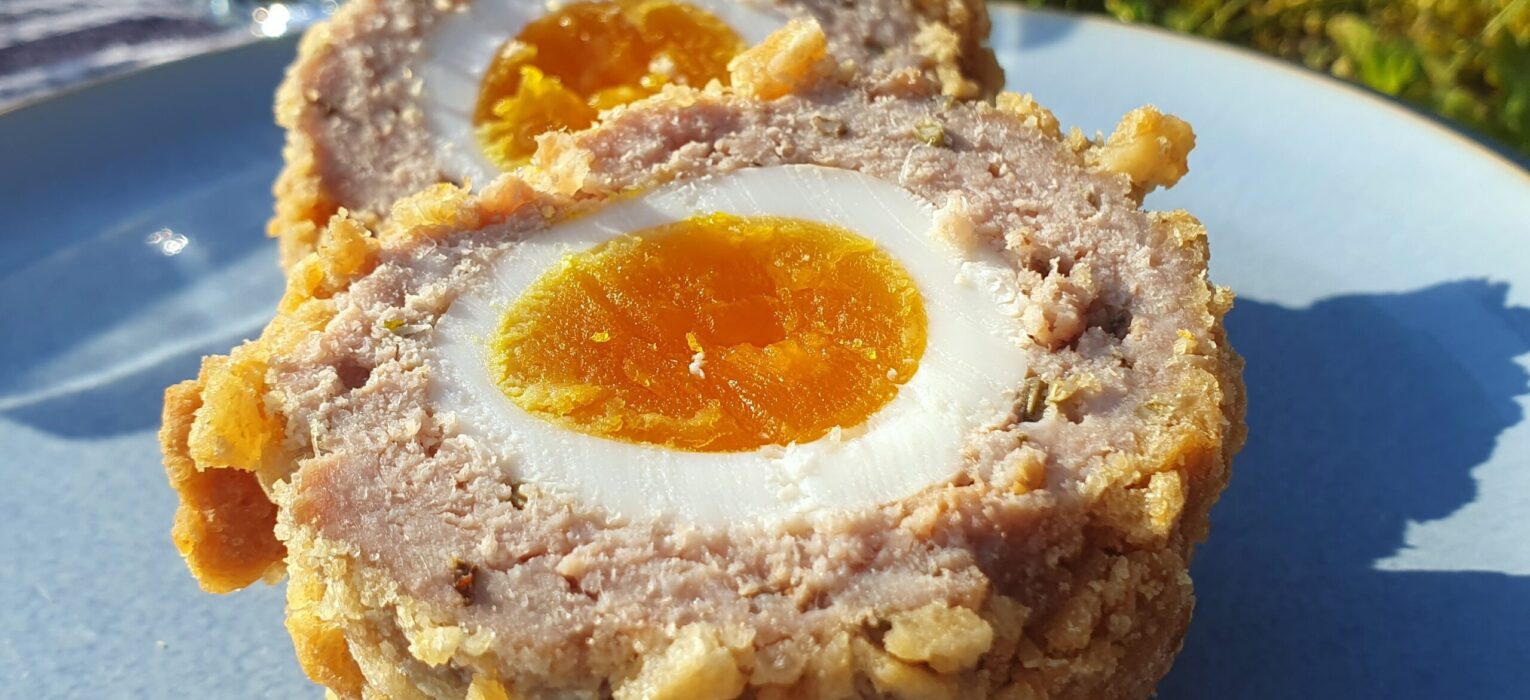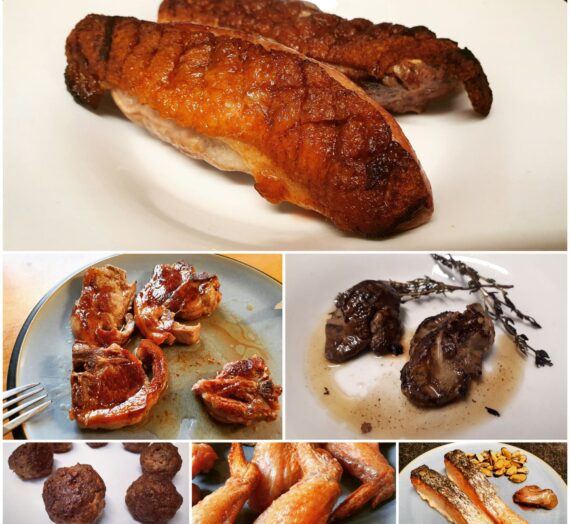This recipe will finally settle the debate on if a Scotch egg constitutes a substantial meal – the answer is yes. If you need a protein fix, look no further; each serving clocks in at 35 grams of protein.
I’ve been labouring under the pretence that Scotch eggs originated in Scotland for nigh on three decades. It came as a revelation to learn that they are not Scottish. Apparently, no self-respecting Scot would call anything but whisky Scotch. The true history of the Scotch egg is hard to pin down as there are conflicting accounts as to its true origin. One account suggests it originated in Whitby in Yorkshire, another North Africa. Still another states it was an Indian import in the early 19th century.
I for one have my money on the simultaneous invention hypothesis. Just as Darwin and Alfred Russel Wallace independently came up with the theory of evolution by making good use of the facts laid bare before them; I think as long as there’s been eggs, meat and human hands to wrap in close proximity to each other, something akin to a Scotch egg would always have been brought into existence by humans.
Regardless of where they originated, they are the perfect summer snack to enjoy anywhere being both transportable and hearty.
If you want, you can jump straight to the recipe. However, I have included more guidance notes under the subheadings below for those of you who want to know more.
I first came across the idea of replacing breadcrumbs with crushed pork scratchings in Cara Comini’s The 30-Day Carnivore Meal Plan. And it’s Comini’s recipe that I have adapted below.
Whole or powdered fennel seeds

I mostly use my mortar and pestle because it makes me feel like an apothecarist concocting a potion, however, another reason to use one is if you want to intensify the flavour of fennel in your Scotch eggs.
Most big supermarkets stock fennel seeds but not fennel seed powder. That’s where a mortar and pestle comes in. When making Scotch eggs for this recipe, I experimented with whole fennel seeds and fennel seed powder, and I liked the results of both.
A benefit of grinding your own seeds is that it increases their surface area, which means you can use less seeds for the same level of flavour. A drawback is that it is a bit of a faff grinding your own, but again, this burden is lessened by getting to feel like an old-timey witch preparing a hex.
A note on eggs
Firstly, I suggest using soft-boiled eggs. To me, there is nothing more visually pleasing then cutting open a Scotch egg and seeing the bright, vibrant yolk ooze out. However, others recoil at that runny viscosity and prefer hardboiled. Ultimately, it is a matter of personal preference. Once wrapped in pork and placed into an oven, the centre of the eggs won’t continue to cook all that much, so that is something to consider whilst boiling them.
If you prefer hardboiled eggs and you are short on time, it might be an idea to buy fresh, boiled eggs from the supermarket. I know Tesco sell them.
Using a wire rack & what to do if you don’t have one
The reason you want to cook your Scotch eggs on a wire rack is to prevent the bottoms from going soggy. Another benefit of the wire rack is that your Scotch eggs cook more evenly without the need to turn them over, and you don’t have to open the oven door whilst they are cooking which could cause the temperature to drop.
If you don’t have a wire rack, you can place the Scotch eggs on a baking tray and turn them halfway through baking to prevent soggy bottoms all round.
Leave the mince-wrapped eggs to bind
After wrapping the mince around the eggs, you want to leave them alone for well over an hour. This is so the mince binds together. Normally egg is used as a binding agent, but in this instance, our binding agent is time. Unless the mince is given time to sit in its new shape for a little while, and if it’s put into the oven too quickly after the ball is formed, you run the risk of having your Scotch eggs fall apart at the seams. And you want your culinary creations to have some stronger nerves.
Which pork scratchings to use and how to process
Ideally, you’d want to make your own pork scratchings from scratch. A lot of scratchings sold in supermarkets are made with rusk, meaning they aren’t gluten-free, contain dextrose, which is another name for sugar, and might negatively impact the gut microbiome, and contain flavour enhancers such as monosodium glutamate (MSG). Large amounts of MSG has been linked to toxic effects including central nervous system (CNS) disorder, obesity, and reproductive issues.
With that being said, I used Mr. Porky Crispy Pork Strips for this recipe and it is guilty of all of the above. My only defence is that once blended in a food processor, the Crispy Strips form a perfect breadcrumb-esque powder, and I was looking for ways to save time. The Original Scratchings from the same brand also taste nice, but due to a higher fat content, don’t make as good a breadcrumbs substitute. You also need to be careful not to overprocess pork scratchings with a higher fat content otherwise you’ll be left with a sort of pork scratching butter, which is as delicious as it sounds, but it’s very hard to coat the balls in.
If possible, the processed scratchings should resemble dry, powdered breadcrumbs – these will adhere better to the mince.
I have tried to like Awfully Posh Pork Crackling as its only two ingredients are salt and pork rinds: the rinds are fried in pork fat, not in vegetable oil which is a huge plus in my book. However, despite how good the product is in theory, every time I’ve tried a packet, to me, it tastes like the inside of a bin.

Ingredients
Base recipe ingredients:
5 boiled eggs
500 g minced pork
1 tsp. ground rock salt
70 g pork scratchings
Optional flavourings per 100g meat:
Sage & Fennel
⅛ tsp. ground, dried fennel seeds
¼ – ½ tsp. dried sage
Sage & Onion
⅛ tsp. onion granules (sometimes also called onion powder)
¼ – ½ tsp. dried sage
Chilli Flakes et al
⅛ tsp. chilli flakes
⅛ tsp. dried sage
⅛ tsp. whole, dried fennel seeds
⅛ tsp. dried oregano
- Peel cooked eggs and place them on a rack to airdry. A dry exterior means the pork mince will stick better to the egg. If you are short on time, you can dry the eggs with clean kitchen towel.
- In a glass mixing bowl, add broken-apart pork mince and salt. Gently mix the salt through making sure it’s evenly distributed but be mindful that too much mixing can make the meat tough.
- If you want to add flavourings, separate out the mixture into roughly 100 g portions. Add flavourings. If you want plain Scotch eggs, skip this step.
- If you’ve already separated out the meat and flavourings into 100 g portions, roughly split each portion into half i.e. 50 g. If you didn’t add flavourings, measure out 50 g portions of the pork-salt mix using a set of kitchen scales until you have ten.
- Instead of immediately making a patty with each 50 g portion, it’s easier to take the mince and lightly form it into a ball, and then pat it down into a patty that roughly fits into the palm of your hand.
- Make a second patty with another portion of minced pork mix.
- Put the first patty into the palm of your hand, and then take a peeled, boiled egg and place it on top.
- Then on top of the egg, place the second patty. If the patty is flavoured, make sure to match it with its twin patty of the same flavouring – unless you want to purposefully make a Scotch egg that’s two different flavours.
- Softly press the two patties together around the egg, making sure you can no longer see the white of the egg by pressing together all seams.




- Repeat with the remaining eggs and pork mix – you should make four more.
- Allow the pork-covered eggs to sit for over an hour. This is so the mince binds together and the seams don’t split open in the oven.

- As they sit, make the ‘breadcrumb’ coating by placing the pork scratchings into a food processor and pulse them until fine crumbs are made. If you don’t have a food processor, putting them into a heavy-duty sandwich bag and then crushing them with a rolling pin will work just as well.
- Preheat the oven to 200 degrees C
- Place the pork scratching breadcrumbs into a shallow dish and roll the pork-covered eggs in the powdery crumbs. Make sure to firmly but carefully press the crumbs into the pork with your hands so that the whole of the outside has a coating.

- Place the Scotch eggs onto a wire rack and bake in the oven for 22 – 25 minutes.
- Serve hot or cold. They will keep for a few days in the fridge.

